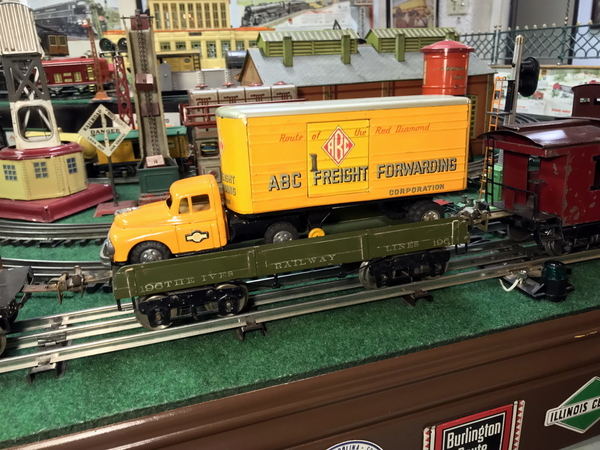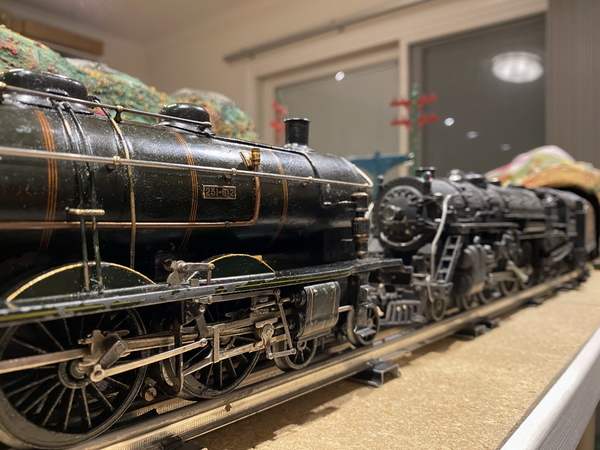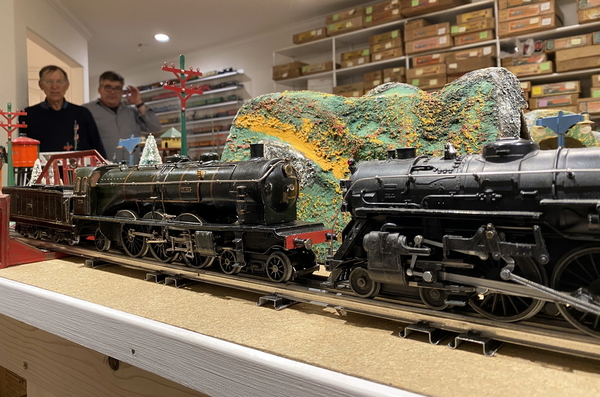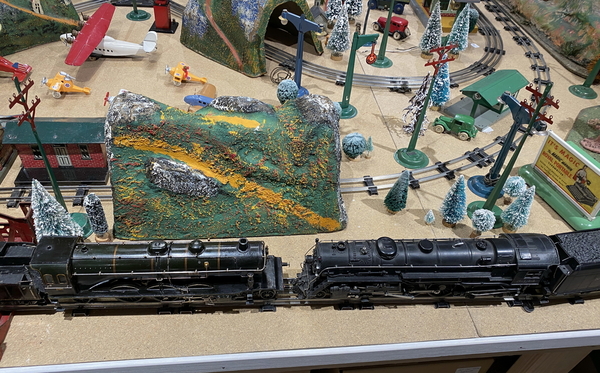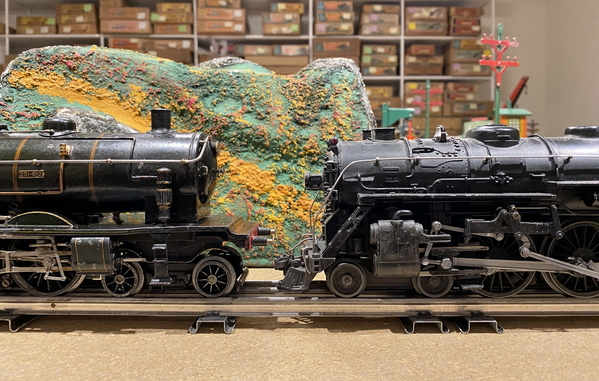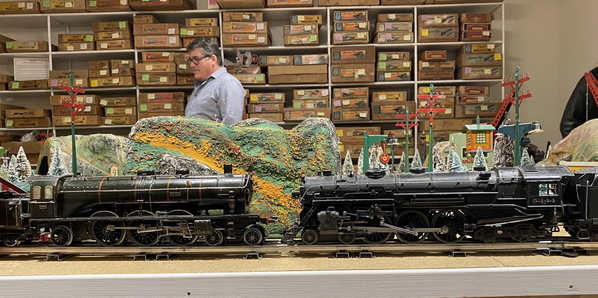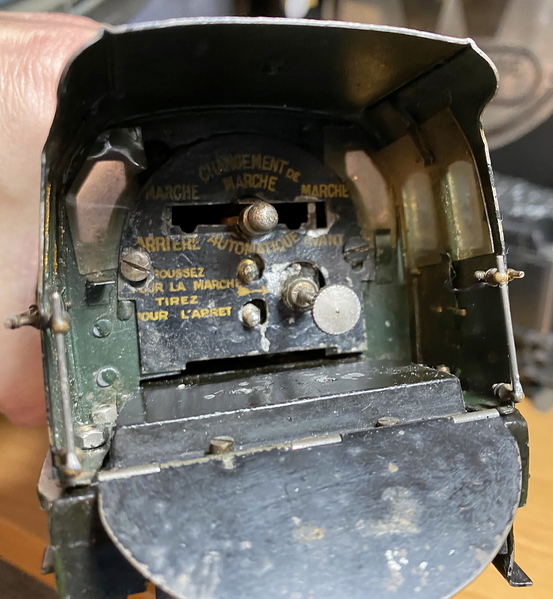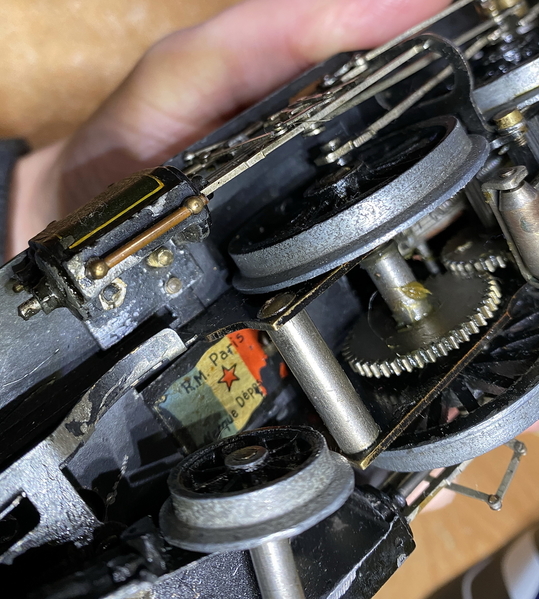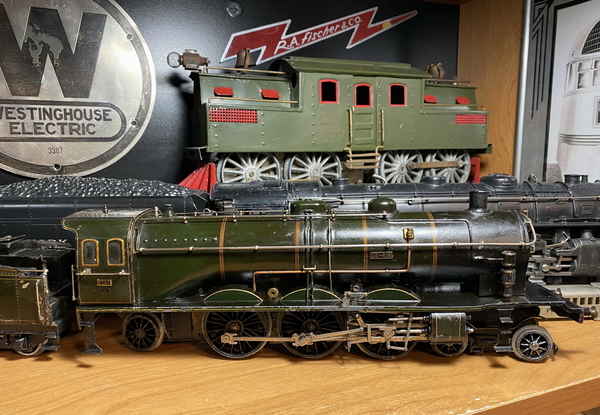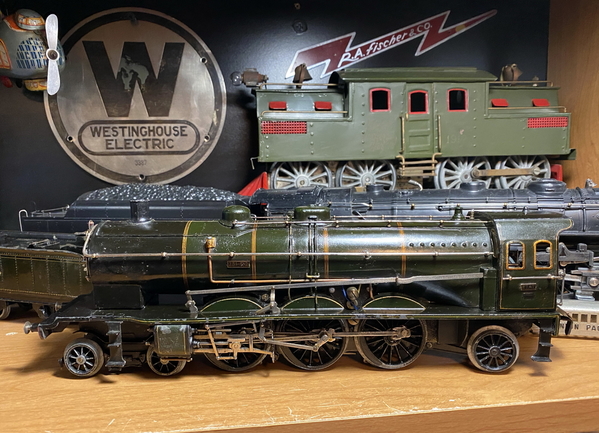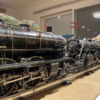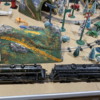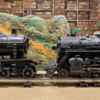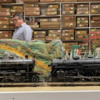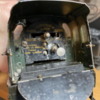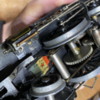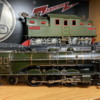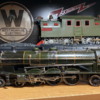ID's here: http://tinplatetoys.blogspot.c...se-tinplate-toy.html
I made these with those Japan push tin toys I used lionels cheapie cabooses frames fit on perfectly and added the. air brakes. thinking of adding interior lights .daniel
Attachments
John Smatlak posted:Steve "Papa" Eastman posted:navy.seal posted:Steve "Papa" Eastman posted:I’ve had this mocked up for some time. Need to get it finished.
steve
Steve,
LOVE IT!!! Reminds me of the Lionel O gauge submarine car I had as a kid.
Bob Nelson
Bob, that was my inspiration. I made one in O a few years ago and someone wanted it REALLY bad so I sold it.
Steve
Here's my flat car load- a tin toy truck on an Ives standard gauge flatcar; fits quite nicely!
Very Nice @John Smatlak !! First, I happen to have that ABC freight trailer- which is totally awesome looking- and also quite large. That big trailer fitting quite nicely on a single flatcar just demonstrates how awesomely, incredibly large standard gauge trains are! Very, Very cool looking layout
A meeting of two O gauge legends- a Marescot French-made Etat Pacific of 1928 and the Lionel scale Hudson of 1937. The Marescot Pacific is something I got recently, so I brought it to our monthly club gathering and another member brought his scale Hudson. Quite a treat to see the two of them together. The Marescot is indeed a beautiful model. As I understand it, these were produced by Robert Marescot in 1928, who is credited as being the pioneer of the "fine scale" model in O gauge. After 1928 Fournereau continued production of his line of trains, creating some wonders of their own. This loco has the "RM Paris" maker's mark underneath (Robert Marescot, Paris), which I understand is the means of differentiating the Marescot production from that of Fournereau, who I understand also produced versions of this model. A video is included of the engine running, enjoy!
Attachments
John Smatlak posted:A meeting of two O gauge legends- a Marescot French-made Etat Pacific of 1928 and the Lionel scale Hudson of 1937. The Marescot Pacific is something I got recently, so I brought it to our monthly club gathering and another member brought his scale Hudson. Quite a treat to see the two of them together. The Marescot is indeed a beautiful model. As I understand it, these were produced by Robert Marescot in 1928, who is credited as being the pioneer of the "fine scale" model in O gauge. After 1928 Fournereau continued production of his line of trains, creating some wonders of their own. This loco has the "RM Paris" maker's mark underneath (Robert Marescot, Paris), which I understand is the means of differentiating the Marescot production from that of Fournereau, who I understand also produced versions of this model. A video is included of the engine running, enjoy!
Your Marescot is in very good condition and running! Nice find. Surprisingly the picture shows the Marescot is higher than the Lionel, must be the scale difference, Marescot used 1:43. The Marescot is nice to scale such that it looks also very good with scale cars instead of Marescot or Fournereau cars.
Regards
Fred
sncf231e posted:John Smatlak posted:A meeting of two O gauge legends- a Marescot French-made Etat Pacific of 1928 and the Lionel scale Hudson of 1937. The Marescot Pacific is something I got recently, so I brought it to our monthly club gathering and another member brought his scale Hudson. Quite a treat to see the two of them together. The Marescot is indeed a beautiful model. As I understand it, these were produced by Robert Marescot in 1928, who is credited as being the pioneer of the "fine scale" model in O gauge. After 1928 Fournereau continued production of his line of trains, creating some wonders of their own. This loco has the "RM Paris" maker's mark underneath (Robert Marescot, Paris), which I understand is the means of differentiating the Marescot production from that of Fournereau, who I understand also produced versions of this model. A video is included of the engine running, enjoy!
Your Marescot is in very good condition and running! Nice find. Surprisingly the picture shows the Marescot is higher than the Lionel, must be the scale difference, Marescot used 1:43. The Marescot is nice to scale such that it looks also very good with scale cars instead of Marescot or Fournereau cars.
Regards
Fred
I was going to make a similar comment about the clear difference in scale. Very nice machine you have there!
John Smatlak what an incredible find, the pictures and video of your Marescot Pacific are terrific. I will be the first to admit that this thread has introduced me to a number of new European lines of trains that I never had even seen before, thanks to all.
As an aside, I could not help but notice in the background of your photos of the two engines that on your club's layout are some interesting litho tinplate structures and tinplate trains. One of the little structures, I believe, is a Flyer pre-war No 93 Town Depot that I just managed to find at our local (Texas) train show and am about to "adopt" onto my layout but your club's lay out has others. Perhaps you might ask the club to post some pictures of their layout. Thanks
Don
Nice Marescot John, they are not so easy to find in very good condition. Now here are the cars from Marescot you will have to find.... he made also a third class one, similar but with one more window.
The name WERY under the baggage car is the name of the shop who sold them around 1928.
Very Best, Daniel
Attachments
Just returned from a train buying vacation to Texas. Here is an unusual American Flyer 1218 engine in green with red lettering. Have never seen any of these engines with red lettering, other than the orange 1218 engines.
The red lettering on green background does not seem to have enough contrast to be readable, so possibly that is why this does not appear to be a common variation. The more typical variation is green with yellow or gold lettering.
Here are some of the more typical variations with gold and yellow lettering.
NWL
Just checked "Greenberg's Guide to American Flyer Prewar O Gauge" and they do not list any such variation for the 1218. The only variation that even lists red rubber stamping states that the body color was "yellow or orange". The only green bodied variant is listed with yellow rubber stamping...So you may have indeed found a new variation. Congratulations.
Don
Don McErlean posted:Just checked "Greenberg's Guide to American Flyer Prewar O Gauge" and they do not list any such variation for the 1218. The only variation that even lists red rubber stamping states that the body color was "yellow or orange". The only green bodied variant is listed with yellow rubber stamping...So you may have indeed found a new variation. Congratulations.
Don
I have learned over the years that the Greenberg's Guide to American Flyer Prewar O Gauge book is lacking in a lot of ways. The book is good, but only as good as the information that was reported. There are a number of variations that have been found since the book was published over 20 years ago. Such is the nature of American Flyer.
NWL
NWL : I know that you are right! I have found things that don't seem to be covered and in addition while Greenberg is reasonable on the trains and cars it does not touch structures such as stations etc which we know exist.
As a quick example, Greenberg lists the 513 coach and 515 observation as only having a "green roof and green and black trim"...I have two 513 coaches and a 515 observation and they have RED roofs... lithographed so they could not have been repainted...sitting just over the desk at which I am sitting right now in my display case.
Unfortunately, at least in my "library" it is the best I have, I sometimes get better data from O'Brien but most of this stuff is old.
Do you know of a more authoritative reference or web site ... if so could you post it. Thanks.
Anyway, regardless of Greenberg, you have found a cool loco !!
Don
John Smatlak posted:A meeting of two O gauge legends- a Marescot French-made Etat Pacific of 1928 and the Lionel scale Hudson of 1937. The Marescot Pacific is something I got recently, so I brought it to our monthly club gathering and another member brought his scale Hudson. Quite a treat to see the two of them together. The Marescot is indeed a beautiful model. As I understand it, these were produced by Robert Marescot in 1928, who is credited as being the pioneer of the "fine scale" model in O gauge. After 1928 Fournereau continued production of his line of trains, creating some wonders of their own. This loco has the "RM Paris" maker's mark underneath (Robert Marescot, Paris), which I understand is the means of differentiating the Marescot production from that of Fournereau, who I understand also produced versions of this model. A video is included of the engine running, enjoy!
A tinplate club!? Where is it? BTW that is one beautiful engine!
Don McErlean posted:NWL : I know that you are right! I have found things that don't seem to be covered and in addition while Greenberg is reasonable on the trains and cars it does not touch structures such as stations etc which we know exist.
As a quick example, Greenberg lists the 513 coach and 515 observation as only having a "green roof and green and black trim"...I have two 513 coaches and a 515 observation and they have RED roofs... lithographed so they could not have been repainted...sitting just over the desk at which I am sitting right now in my display case.
Unfortunately, at least in my "library" it is the best I have, I sometimes get better data from O'Brien but most of this stuff is old.
Do you know of a more authoritative reference or web site ... if so could you post it. Thanks.
Anyway, regardless of Greenberg, you have found a cool loco !!
Don
Please post pictures of your 513 and 515 cars with red roofs. They sound interesting. I am guessing there is no green on the car?
As for a better reference or website for American Flyer Prewar O gauge, there really is none. I have just acquired a vast knowledge of Flyer O gauge after collecting it for over 35 years. There are a few friends I network with to share knowledge with or call if I have questions. I also have a vast inventory of advertisements and paperwork, which help to fill in some of the holes that are not covered by the Flyer catalogs.
NWL
Will posted:John Smatlak posted:A meeting of two O gauge legends- a Marescot French-made Etat Pacific of 1928 and the Lionel scale Hudson of 1937. The Marescot Pacific is something I got recently, so I brought it to our monthly club gathering and another member brought his scale Hudson. Quite a treat to see the two of them together. The Marescot is indeed a beautiful model. As I understand it, these were produced by Robert Marescot in 1928, who is credited as being the pioneer of the "fine scale" model in O gauge. After 1928 Fournereau continued production of his line of trains, creating some wonders of their own. This loco has the "RM Paris" maker's mark underneath (Robert Marescot, Paris), which I understand is the means of differentiating the Marescot production from that of Fournereau, who I understand also produced versions of this model. A video is included of the engine running, enjoy!
A tinplate club!? Where is it? BTW that is one beautiful engine!
You mistake tinplate club as the club having its own layout, as opposed to a tinplate club that meets at various clubmembers' homes. I recognize the place and have been there a couple of times. After following John's postings, I am going to have to make sure I meet him the next time I make one of the club meetings Los Angeles.
NWL
NWL : Here are the pictures of the 513 Observation and 515 Coach with the red roofs. You were correct there is "No Green" anywhere on the cars.

Here is the side view, other side is identical. I do have a second coach but it is the same as this one so I didn't include it.
I think these are about the least expensive passenger coaches Flyer made , my data (also from Greenberg) says manufacture between 1925 -1929

Here is the end view. The non-platform end of the Observation is exactly like that of the coach except it has 513 over the door. Both cars state..."Made in USA" in the lithography just under the number in the first portion of the yellow section. Another interesting feature is that cars are tab/slot (or more like tab / hoop) couplers but the tab coupler on the observation swivels as it is connected to the floor via a rivet. The couplers on the coaches are fixed although the hole for the rivet is present in the floor. I expect that the hoop provided sufficient side to side motion to allow the cars to go around a curve. I have seen these referred to as "Hummer" type cars although they were introduced somewhat later and are slightly longer. I have always assumed they were pulled with a Hummer type 3 mechanical loco.
Their method of manufacture is interesting to me as an engineer. The entire car except the floor , axles , and wheels is one piece of lithographed sheet metal. This one piece of sheet metal includes the observation platform on the observation car, it is not a separately added piece. Obviously lithographed flat then folded (like Origami) to make the car. Tabs are folded into slots in the floor to fasten the car to the floor. The journal boxes are part of the upper sheet and simply hold the axles via being positioned well in from the end of the axle.
Anyway there they are ... Red, Yellow, Black (no Green) enjoy!
Don
Attachments
Don McErlean posted:NWL : Here are the pictures of the 513 Observation and 515 Coach with the red roofs. You were correct there is "No Green" anywhere on the cars.
Here is the side view, other side is identical. I do have a second coach but it is the same as this one so I didn't include it.
I think these are about the least expensive passenger coaches Flyer made , my data (also from Greenberg) says manufacture between 1925 -1929
Here is the end view. The non-platform end of the Observation is exactly like that of the coach except it has 513 over the door. Both cars state..."Made in USA" in the lithography just under the number in the first portion of the yellow section. Another interesting feature is that cars are tab/slot (or more like tab / hoop) couplers but the tab coupler on the observation swivels as it is connected to the floor via a rivet. The couplers on the coaches are fixed although the hole for the rivet is present in the floor. I expect that the hoop provided sufficient side to side motion to allow the cars to go around a curve. I have seen these referred to as "Hummer" type cars although they were introduced somewhat later and are slightly longer. I have always assumed they were pulled with a Hummer type 3 mechanical loco.
Their method of manufacture is interesting to me as an engineer. The entire car except the floor , axles , and wheels is one piece of lithographed sheet metal. This one piece of sheet metal includes the observation platform on the observation car, it is not a separately added piece. Obviously lithographed flat then folded (like Origami) to make the car. Tabs are folded into slots in the floor to fasten the car to the floor. The journal boxes are part of the upper sheet and simply hold the axles via being positioned well in from the end of the axle.
Anyway there they are ... Red, Yellow, Black (no Green) enjoy!
Don
Actually, those cars are described as versions B & C under the 513 & 515 descriptions. They are fairly common and they are poorly described in the Greenbergs guide.
NWL : Well you got me there...my version of the Greenberg Prewar Flyer book (1987 ) has no B or C versions of these cars listed, just the green roof ones in a 3 line entry. So maybe someone has updated the data in a later version. Anyway given their low cost at the time of manufacture I would expect them to be fairly common.
Don
Don McErlean posted:NWL : Well you got me there...my version of the Greenberg Prewar Flyer book (1987 ) has no B or C versions of these cars listed, just the green roof ones in a 3 line entry. So maybe someone has updated the data in a later version. Anyway given their low cost at the time of manufacture I would expect them to be fairly common.
Don
Don,
I have not looked at the 1987 edition in years. The guide was updated in the late 90s (I think in 1997), with that version having a blue cover showing a 1096 engine.
NWL




